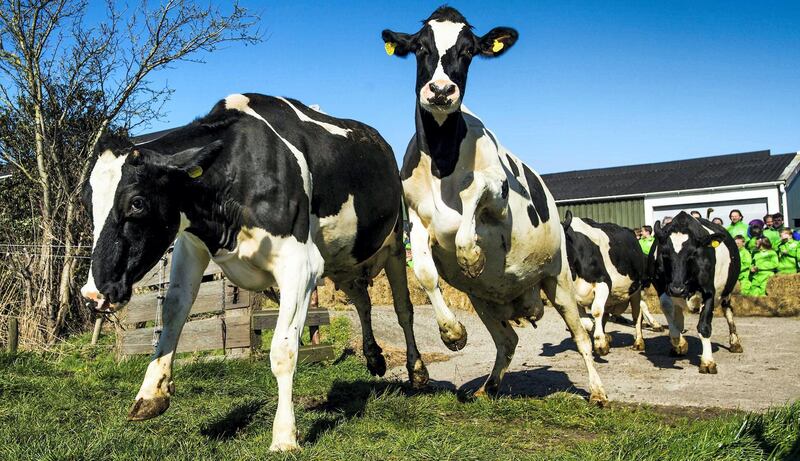In the coming 50 years the world will have to produce and sell as much food as it did in the past 4,000, a food security expert says.
“It’s a challenging time at the moment because when we look ahead, the world will change considerably,” said Dr Aalt Dijkhuizen, president of Topsector Agri and Food in the Netherlands.
“Three billion people will move from low income to middle class and this has the biggest effect in the short term because it means in the coming 40 to 50 years, we have to produce and sell as much food as we did in the past 4,000 years. It’s amazing.”
Topsector Agri and Food is a collaboration and innovation network between government, private partners and research institutes.
The Netherlands, the second-biggest food exporter after the US, is one of the countries with which the UAE has formed partnerships to help secure its food in the future. The UAE imports about 90 per cent of its food requirements.
In February last year, Sultan Al Mansoori, the Minister of Economy, visited the Netherlands where both countries signed an agreement on food innovation co-operation.
There is expected to be a tremendous increase in demand for high-quality protein. Demand for vegetables, dairy products and meat is set to double.
“It’s a big challenge but also a big opportunity for people in the food and agriculture industry,” Dr Dijkhuizen said. “It’s doable but a lot of work needs to be done.
“The total land for agriculture will decline and resources will become more limited so we have to do better. It sounds easy but doing more of the same is much easier than doing better.
“The entire world needs to produce food in a better way, and that takes a generation.”
The Netherlands, a small country of 45,000 square kilometres, surpassed €100 billion (Dh452.9bn) in exports last year. The country gets five times more value from every hectare than the rest of Europe.
“We produce a lot ourselves, like dairy and meat, but also import a lot of ingredients like soil, so it’s a combination of our own production and import,” Dr Dijkhuizen said.
“Our biggest sector is horticulture and livestock, and we don’t have a lot of extensive production systems or a lot of arable land. Our land and labour is too expensive, so each square metre should be used as much as possible.
“We have high levels of production and a short production chain so everything is planned ahead. This was the only way for the Dutch sector to survive, by being ahead in innovation.”
Wageningen University and Research Centre is the only university in the Netherlands to focus on healthy food. The institute, which opened in 1876, consistently ranks as one of the world’s top universities and is considered one of the best in the world in life sciences.
“We use the lowest amount of land per kilogramme of food,” Dr Dijkhuizen said. “Because we are so productive, we can do a lot with 1 litre of water or 1 kilogram of soil, so greenhouse gas emissions are very low per kilogramme of product.
“It’s an everlasting incremental improvement in all the fields in all areas of the chain and a tremendous chain of small steps, which is why it takes so much time for countries that need to speed it up now.
“You need to have knowledge, the right facilities, input and processing industry.”
_____________
Read more:
How to feed the world: six foods to sustain a growing population
Opinion: Producing more food in the UAE can help us maintain food security in the long term
How RAK's Digdagga experimental farm revolutionised agriculture in the 1960s
_____________
These constant improvements include better breeds and seeds, machinery, equipment such as greenhouses, housing systems, animal dry feed, crop protection and health management and storage.
To establish such practices requires a long-term commitment between public and private sectors and researchers from an early stage.
“It’s the so-called triple helix,” Dr Dijkhuizen said. “We also have 400 ingredients in the feed for our cattle, pork and poultry, with waste and leftovers from the food industry that are used to make quality feed.”
But priorities have to be set together. The Dutch government does not spend a lot on research and development. It is up to the public-private partnerships to set goals and invest together, “because when you do, you come further” the doctor said.
The Netherlands regularly welcomes students from hundreds of countries, including some from the UAE. It has made food, water and energy its top priorities since 2010 because, “at the end of the day that’s what people need”.
*******
The Dutch centre where excellence regularly crops up
Wageningen University and Research Centre focuses on agro-technology and food sciences as well as animal, environmental, plant and social sciences.
Its approach is to focus on the economy, defining areas where it is strong and building on them.
Its funding is split between the government and private industry, which includes up to €200 million (Dh902.2m) for research and development in agriculture and food. It also receives resources from the EU.
Every four years, the centre redefines its priorities. Some of the new technology it envisages are sensors, drones and robotics to more precisely measure the food production process, the use of fertiliser and water management, in the hope that they will allow farmers to be able to detect diseases in crops and animals earlier and act immediately.
Technology will allow efficient cooling, transport and storage because intelligent systems can measure ambient temperatures and adjust accordingly to save energy.
Genomics enables genes to breed faster, have tailor-made management of crops and animals and personalised nutrition for consumers.
The centre ranked first in agriculture and forestry in the QS World University Rankings 2017 to 2018.
Wageningen University and Research, with one faculty, five departments, 85 chair groups, 224 professors and 10,000 students, was 65th in the Times Higher Education World University Rankings in 2016 to 2017.






